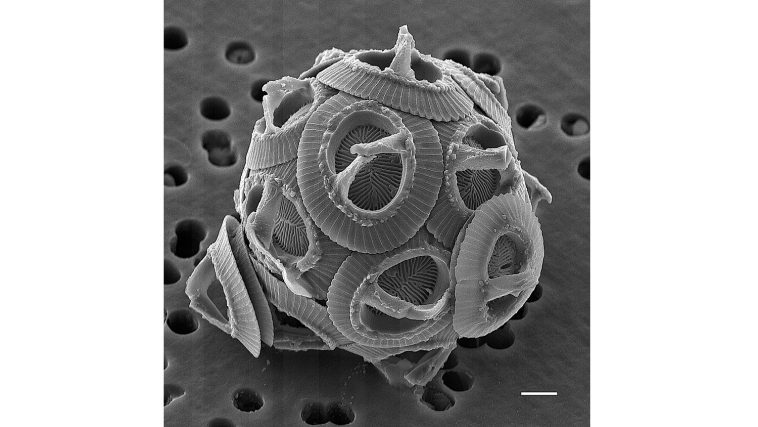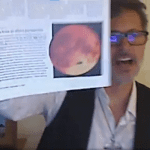[Originally published as Yet Another Global Warming Alarmist Prediction Has Been Falsified. View image source HERE]
The best way to evaluate a scientific hypothesis is to use it to make predictions, which can then be compared to observations. The more the predictions line up with the observations, the more scientific merit the hypothesis has.
Based on this commonly-used evaluation, the hypothesis that increased carbon dioxide levels in the atmosphere will result in catastrophic climate change has virtually no scientific merit whatsoever. As I have discussed previously (see here, here, here, here, and here), the predictions made by global warming alarmists have been demonstrated to be wrong time and time again. Recently, I ran across another study that adds to this growing list of falsified predictions.
The picture shown above is of an ocean-dwelling microscopic organism known as a coccolithophore. It makes its own food via photosynthesis, and it also makes the “plates” that you see covering it. It makes them by absorbing bicarbonate (HCO3–) and calcium from ocean water and making calcium carbonate (CaCO3). When coccolithophores die, their calcium carbonate plates sink to the bottom of the ocean, making deposits of chalk.
Now it turns out that this process of making plates out of calcium carbonate is influenced by the acidity of the water. The more acidic the water, the harder it is for coccolithophores (and all organisms that do the same chemistry) to make calcium carbonate. Well, increasing levels of carbon dioxide lead to increasing acidity (technically, lowering alkalinity) of ocean water since carbon dioxide can react with water to form carbonic acid. It is therefore assumed that rising carbon dioxide levels in the atmosphere will harm coccolithophores. As one book on biodiversity puts it:
Higher atmospheric carbon dioxide levels, by making oceans more acidic, could reduce coccolithophore populations (by interfering with their skeletal formation), thereby reducing a major CO2 sink and leading to still higher levels of atmospheric CO2 concentrations.¹
Fortunately, actual scientific observations demonstrate precisely the opposite.
Sara Rivero-Calle and her colleagues studied coccolithophore populations over a 45-year period (from 1965 to 2010). They showed that coccolithophore populations have increased tenfold over that time period. What caused the increase? Here’s what they say:
Our study shows a long-term basin-scale increase in coccolithophores and suggests that increasing CO2 and temperature have accelerated the growth of a phytoplankton group that is important for carbon cycling.²
In other words, the prediction made by global warming alarmists is exactly the opposite of reality. Rather than dwindling as a result of increasing carbon dioxide levels, coccolithophore populations have exploded.
These results illustrate something even more important about the earth’s climate.
Many global warming alarmists think that the earth was pieced together haphazardly as a result of random interactions guided by the laws of physics. As a result, they don’t think it has the ability to withstand significant changes. Indeed, they think the earth is so poorly constructed that small changes can cause it to completely spiral out of control.
Consider, for example, the quote I gave from the book on biodiversity. It claims that increasing carbon dioxide levels will result in the decline of coccolithophores, which would cause even more increases in carbon dioxide. This is called a positive feedback loop — a change produces a series of events that increase the severity of that change. Most global warming alarmists think that the earth has lots of positive feedback loops.
Because I think the earth is designed, I expect precisely the opposite. I expect the earth to be full of negative feedback loops, where a change produces a series of events that work to reduce the severity of the change. All well-designed systems contain negative feedback loops, and the earth is no exception (see here, here, here, and here). The change in coccolithophore populations in response to increasing carbon dioxide is just one more example of such a negative feedback loop.
When coccolithophore populations increase, photosynthesis increases. This, of course, reduces atmospheric carbon dioxide. That’s a classic negative feedback loop — more carbon dioxide produces more photosynthetic creatures, which reduces carbon dioxide. In addition, remember what happens when coccolithophores die. Their calcium carbonate plates fall to the bottom of the ocean. The calcium carbonate contains carbon, so the more coccolithophores that die, the more carbon gets sent to the bottom of the ocean, removing it from the cycle that could put it back into the atmosphere in the form of carbon dioxide.³
But this negative feedback loop is even more impressive because not only do increases in coccolithophore populations decrease carbon dioxide, they decrease the temperature of the planet! One very important factor that affects the temperature of any planet is its albedo, which is the amount of light reflected by the planet’s surface. The higher the albedo, the more light gets reflected and the cooler the planet.
Guess what increasing coccolithophore populations do to the earth’s albedo? They increase it.4 Thus, even if increasing carbon dioxide produces increasing temperature, it will also produce an increasing albedo, which will fight against an increasing temperature!
So the fact that coccolithophore populations have increased in response to carbon dioxide levels in the atmosphere not only falsifies yet another prediction made by global warming alarmists, but it also demonstrates how well-designed the earth is. The more I study the earth, the more I come to appreciate that fact.
References
- Sustaining Life: How Human Health Depends on Biodiversity, Eric Chivian and Aaron Bernstein (Ed.), Oxford University Press 2008, pp. 69-70
- Sara Rivero-Calle, Anand Gnanadesikan, Carlos E. Del Castillo, William Balch, and Seth D. Guikema, “Multidecadal increase in North Atlantic coccolithophores and the potential role of rising CO2,” Science DOI: 10.1126/science.aaa8026, 2015
- Saving Biological Diversity: Balancing Protection of Endangered Species and Ecosystems, Robert A. Askins, Glenn D. Dreyer, Gerald R. Visgilio, Diana M. Whitelaw (Ed.), Springer 2008, p. 191
- William Balch, Patrick M. Holligan, Steven Ackleson, and Kenneth J. Voss, “Biological and optical properties of mesoscale coccolithophore blooms in the Gulf of Maine,” Limnology and Oceanography 36(4): 629-643, 1991







